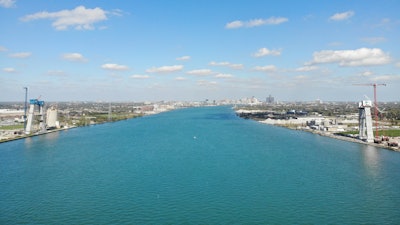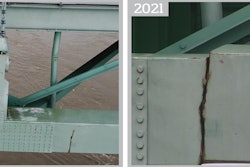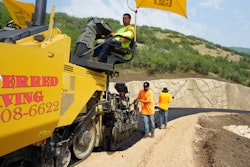
Construction progresses on what will become the longest cable-stayed main span in North America, on the Gordie Howe International Bridge between the U.S. and Canada.
And the construction is not without some patriotic spirit as this video by the Gordie Howe International Bridge Project shows of the rising of the Detroit-side tower between November 2020 and September 2021:
The post-tensioning of the foundations for the two towers, one in Detroit and one in Windsor, Ontario, was completed in summer. Work continues on building the towers, which will each stand 720 tall.
The two towers’ temporary climbing systems, which rise as the towers rise, also currently depict images and colors to represent the U.S. and Canada, respectively.
On the Detroit side, the images include murals of an eagle, the “Spirit of Detroit” monument and an American flag with workers in the foreground – all on a blue background. The murals on the Canadian side depict the maple leaf, polar bears and other cultural scenes.
Check out this video by the Gordie Howe International Bridge Project of the tower construction on the Canadian side of the Detroit River between July 2020 and September 2021:
A total of 1,426 steel strands were used to connect the tower footings on the U.S. and Canadian towers, according to the Windsor-Detroit Bridge Authority. Each strand is 236 feet long and weighs 519 pounds.
“The cables pull the footings together, so they work as one and handle the tower loads and eventually the road deck,” says Frank Raji, the bridge authority’s director of construction.
When the six-lane bridge opens, which is expected to occur in 2024, it will have the longest main span of any cable-stayed bridge in North America at .53 miles, according to the bridge authority.
The towers are at about half the 722-foot height they will eventually reach. The road surface will be at 138 feet high.
The towers have an inverted “Y” design, with the top pylon head at 262 feet to house the 216-strand cable-stayed system.
The $4.4 billion bridge is being designed, constructed and will be maintained by a partnership of Fluor, ACS Infrastructure Canada and Aecon Group. Construction began in 2018.
Images below show the tower pylon designs and a rendering of the completed bridge:
 The climbing systems for the U.S. tower feature murals by Detroit artist Roberto Villalobos.Gordie Howe International Bridge Project
The climbing systems for the U.S. tower feature murals by Detroit artist Roberto Villalobos.Gordie Howe International Bridge Project
 A schematic drawing for the pylon design for the towers for the Gordie Howe International BridgeGordie Howe International Bridge Project
A schematic drawing for the pylon design for the towers for the Gordie Howe International BridgeGordie Howe International Bridge Project
 A rendering of the future Gordie Howe International Bridge, scheduled to be completed in 2024.Gordie Howe International Bridge Project
A rendering of the future Gordie Howe International Bridge, scheduled to be completed in 2024.Gordie Howe International Bridge Project














